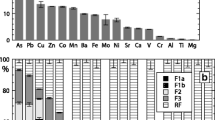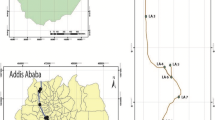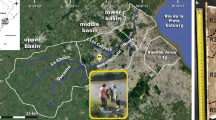Abstract
Although Lebanon has abundant water, its rivers are polluted and aquifer water mismanaged. Effective river water usage requires an understanding of the geochemistry of polluting metals in catchments. Climate is “Mediterranean”: wet winters and dry summers. Active sediment flushing is restricted to winter high discharge episodes. Except in winter, water column pollutants are removed by precipitation or sorption to the surface of static bed sediments. Hence (1) does winter flushing of contaminated sediment and replacement by clean sediment favour self purification? (2) does the distribution of metals between extractable fractions change seasonally and thereby affect metal bioavailability ? Results on the distribution of metals are reported for Fe, Pb, Zn, Cu and Cd in bed sediments from Nahr Ibrahim (a karstic river) for summer and winter. A Tessier-like sequential extraction scheme was applied to samples (< 75 μm) for five locations along a 13 km stretch to the sea. Water pH was above 8.2 at all locations implying a very low solubility for Fe. Sediment was derived from catchment soils and limestone. Total sediment Fe increased in winter at all sites following deposition of eroded soil from upstream. Cadmium, Cu and Pb derived from polluting sources; the sources of Zn were more complex. Dilution by clean sediment explained winter reductions in total Cd, Cu and Pb; Zn changes were less consistent. Iron occurred mostly (> 77 sum of fractions) in the residual fraction compared with 6– 31 for pollutants; residual Cu and Zn showed a small increase in winter whereas Cd and Pb did not change. All readily exchangeable metals decreased in winter and the carbonate bound forms predominated in both seasons. Nahr Ibrahim has a high capacity for self purification and metal resolubilisation from sediment will be limited by the solubility of carbonate forms.
Similar content being viewed by others
Change history
30 April 2006
An Erratum to this paper has been published: https://doi.org/10.1007/s10653-006-1913-1
References
A-FM Abdel-Rahman FH. Nader (2002) ArticleTitleCharacterization of the Lebanese Jurassic-Cretaceous carbonate stratigraphic sequence: a geochemical approach Geol. J 37 69–91 Occurrence Handle10.1002/gj.902
Amery HA. 2002 Irrigation planning in Lebanon: challenges and opportunities. in Mehmet Ö, and Biçak HA (eds), Modern and Traditional Irrigation Technologies in the Eastern Mediterranean. Ottawa , Ontario Canada: IDRC 2002 publication, chapter 6.
JLG Ariza D Giraldez D Sanchez-Rodas E. Morales (2000) ArticleTitleSelective assessment of a sequential extraction procedure for metal mobility characterization using model phases Talanta 52 545–554 Occurrence Handle10.1016/S0039-9140(00)00410-0
NH Baghdady J. Sippola (1983) ArticleTitleTotal heavy metal recovery by aqua regia in soils of different origin Annales Agriculturae Fenniae 22 175–178
G Benoit TF. Rozan (1999) ArticleTitleThe influence of size distribution on the particle concentration effect and trace metal partitioning in rivers Geochimica et Cosmochimica Acta 63 113–127 Occurrence Handle10.1016/S0016-7037(98)00276-2
TT. Chao (1972) ArticleTitleSelective dissolution of manganese oxides from soils and sediments with acidified hydroxylamine hydrochloride Soil Sci. Soc. Am. Proc. 36 764–768 Occurrence Handle10.2136/sssaj1972.03615995003600050024x
D. Chapman (1992) Water Quality Assessments Chapman and Hall London UK 583
TM Darwish RA. Zurayk (1997) ArticleTitleDistribution and nature of Red Mediterranean soils in Lebanon along an altitudinal sequence Catena 28 191–202 Occurrence Handle10.1016/S0341-8162(96)00037-9
U Forstner GTW. Wittmann (1979) Metal pollution in the aquatic environment Springer-Verlag Berlin Germany 486
IDL Foster SM. Charlesworth (1996) ArticleTitleHeavy metals in the hydrological cycle: trends and explanations Hydrol. Proces 10 227–261 Occurrence Handle10.1002/(SICI)1099-1085(199602)10:2<227::AID-HYP357>3.0.CO;2-X
M. Grant (1988) The ancient Mediterranean Meridian (Penguin Group) New York 374
AV. Hirner (1992) ArticleTitleTrace element speciation in soils and sediments using sequential chemical extraction methods Int. J. Environ. Anal. Chem. 46 77–85
M Jurdi SI Korfali Y Karahagopian BE Davies (2001) ArticleTitleA prototype study for the management of surface water resources, Lebanon Water Policy 3 41–46 Occurrence Handle10.1016/S1366-7017(00)00029-5
M Jurdi SI Korfali Y Karahagopian BE. Davies (2002) ArticleTitleEvaluation of water quality of the Qaraaoun Reservoir, Lebanon Suitability for multipurpose usage Environ. Moni. Assess. 77 11–30 Occurrence Handle10.1023/A:1015781930601
M Kersten U. Forstner (1989) Speciation of trace metals in sediments GE Batley (Eds) Trace Element Speciation: Analytical and Problems. CRC Press Inc Boca Raton Florida 247–317
M Kersten U. Forstner (1995) Speciation of trace metals in sediments and combustion wastes AM Ure CM Davidson (Eds) Chemical speciation in the environment. Blackie Academic & Professional London 234–275
SI Korfali BE. Davies (2000) ArticleTitleTotal and extractable trace elements in Lebanese river sediments: dry season data Environ. Geochem. Health. 22 265–273 Occurrence Handle10.1023/A:1006791930010
DW Lewis DM. McConchie (1994) Analytical Sedimentology Chapman and Hall New York, USA 197
Y-H. Li (2000) A Compendium of Geochemistry Princeton University Press Princeton, NJ, USA 475
WL. Lindsay (1979) Chemical equilibria in soils John Wiley and Sons New York 449
WP Miller DC Martens LW. Zelazny (1986) ArticleTitleEffect of sequence in extraction of trace metals from soils Soil. Sci. Soc. Am. J 50 598–601 Occurrence Handle10.2136/sssaj1986.03615995005000030011x
P Quevauviller M Lachica E Barahona G Rauret A Ure A Gomez H. Muntau (1996) ArticleTitleInterlaboratory comparison of EDTA and DTPA procedures prior to certification of extractable trace elements in calcareous soil Sci. Tot. Environ 178 127–132 Occurrence Handle10.1016/0048-9697(95)04804-9
H. Rendell (1997) Earth surface processes in the Mediterranean R King L Proudfoot B Smith (Eds) The Mediterranean Environment and Society Arnold London 45–56
W Salomons U. Forstner (1984) Metals in the Hydrocycle Springer-Verlag Berlin Germany 349
KJ Sene TJ Marsh A. Hachache (1999) ArticleTitleAn assessment of the difficulties in quantifying the surface water resources of Lebanon Hydrol Sci 44 79–96 Occurrence Handle10.1080/02626669909492204
A Tessier PGC Campbell M. Bisson (1979) ArticleTitleSequential extraction procedure for the speciation of particulate trace metals Analytical Chemistry 51 844–851 Occurrence Handle10.1021/ac50043a017
AM Ure ML. Berrow (1982) The elemental constituents of soils HJM Bowen (Eds) Environmental Chemistry NumberInSeriesvol 2. Royal Society of Chemistry London 94–204
DE Walling PN Owens GJL. Leeks (1998) ArticleTitleThe role of channel and floodplain storage in the suspended sediment budget of the River Ouse, Yorkshire, UK Geomorphology 22 225–242 Occurrence Handle10.1016/S0169-555X(97)00086-X
MA Zwarich JG. Mills (1971) ArticleTitleAn evaluation of three methods for the quantitative determination of calcite and dolomite in soils and geological sediments Can. J. Earth Sci 8 967–972
Author information
Authors and Affiliations
Corresponding author
Rights and permissions
About this article
Cite this article
Korfali, S.I., Davies, B.E. Seasonal Variations of Trace Metal Chemical Forms in Bed Sediments of a Karstic River in Lebanon: Implications for Self-purification. Environ Geochem Health 27, 385–395 (2005). https://doi.org/10.1007/s10653-004-7096-8
Received:
Accepted:
Issue Date:
DOI: https://doi.org/10.1007/s10653-004-7096-8




